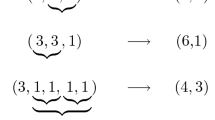Abstract
Given a word w = w 1 w 2 · · · w n , we will call an ordered pair (i, j) for which 1 ≤ i < j ≤ n and w i < w j a free rise. In this paper, we consider two classes of set partitions having cardinality given by the m-Fibonacci numbers and enumerate them according to the number of free rises, where partitions are represented, canonically, as restricted growth functions. In addition, we identify several classes of partitions avoiding two patterns of length four and having cardinality given by the Fibonacci numbers of even index. We enumerate two of these classes jointly according to the number of blocks and to the number of free rises, where we now require that the larger letter in a free rise correspond to the left-most occurrence of a letter of its kind. The resulting x, q-polynomials seem to be new and several identities are derived generalizing those of the even-indexed Fibonacci numbers.
Similar content being viewed by others
References
Benjamin, A.T., Quinn, J.J.: Proofs that Really Count: The Art of Combinatorial Proof. Math. Assoc. Am. (2003)
Carlitz L.: Fibonacci notes 3: q-Fibonacci numbers. Fibonacci Quart. 12, 317–322 (1974)
Cigler J.: Some algebraic aspects of Morse code sequences. Discr. Math. Theor. Comput. Sci. 6, 55–68 (2003)
Cigler, J.: A new class of q-Fibonacci polynomials. Electron. J. Combin. 10, R19 (2003)
Goyt A.: Avoidance of partitions of a three element set. Adv. Appl. Math. 41, 95–114 (2008)
Goyt A., Sagan B.: Set partition statistics and q-Fibonacci numbers. Eur. J. Combin. 30, 230–245 (2009)
Jelínek, V., Mansour, T.: On pattern-avoiding partitions. Electron. J. Combin. 15, R39 (2008)
Klazar M.: On abab-free and abba-free set partitions. Eur. J. Combin. 17, 53–68 (1996)
Knopfmacher, A., Mansour, T., Wagner, S.: Records in set partitions. Electron. J. Combin. 17, R109 (2010)
Knuth, D.E.: The Art of Computer Programming, vol. 1. Addison-Wesley, Reading (1968)
Knuth, D.E.: The Art of Computer Programming, vol. 3. Addison-Wesley, Reading (1973)
Munarini E.: A combinatorial interpretation of the generalized Fibonacci numbers. Adv. Appl. Math. 19, 306–318 (1998)
Rivlin, T.: Chebyshev Polynomials: From Approximation Theory to Algebra and Number Theory. Wiley, New York (1990)
Sagan B.E.: Pattern avoidance in set partitions. Ars Combin. 94, 79–96 (2010)
Shattuck, M., Wagner, C.: A new statistic on linear and circular r-mino arrangements. Electron. J. Combin. 13, R42 (2006)
Shattuck, M., Wagner, C.: Some generalized Fibonacci polynomials. J. Integer Seq. 10, Art.7.5.3 (2007)
Simion R., Schmidt F.W.: Restricted permutations. Eur. J. Combin. 6, 383–406 (1985)
Sloane, N.J.: The On-Line Encyclopedia of Integer Sequences. http://www.oeis.org
Stanley, R.P.: Enumerative Combinatorics, vol. I. Wadsworth and Brooks/Cole, Pacific Grove (1986)
Stanton, D., White, D.: Constructive Combinatorics. Springer (1986)
Wachs M., White D.: p,q-Stirling numbers and set partition statistics. J. Combin. Theory Ser. A 56(1), 27–46 (1991)
West J.: Generating trees and the Catalan and Schröder numbers. Discr. Math. 146, 247–262 (1995)
West J.: Generating trees and forbidden subsequences. Discr. Math. 157, 363–374 (1996)
Author information
Authors and Affiliations
Corresponding author
Rights and permissions
About this article
Cite this article
Mansour, T., Shattuck, M. Free rises, restricted partitions, and q-Fibonacci polynomials. Afr. Mat. 24, 305–320 (2013). https://doi.org/10.1007/s13370-011-0060-8
Received:
Accepted:
Published:
Issue Date:
DOI: https://doi.org/10.1007/s13370-011-0060-8




